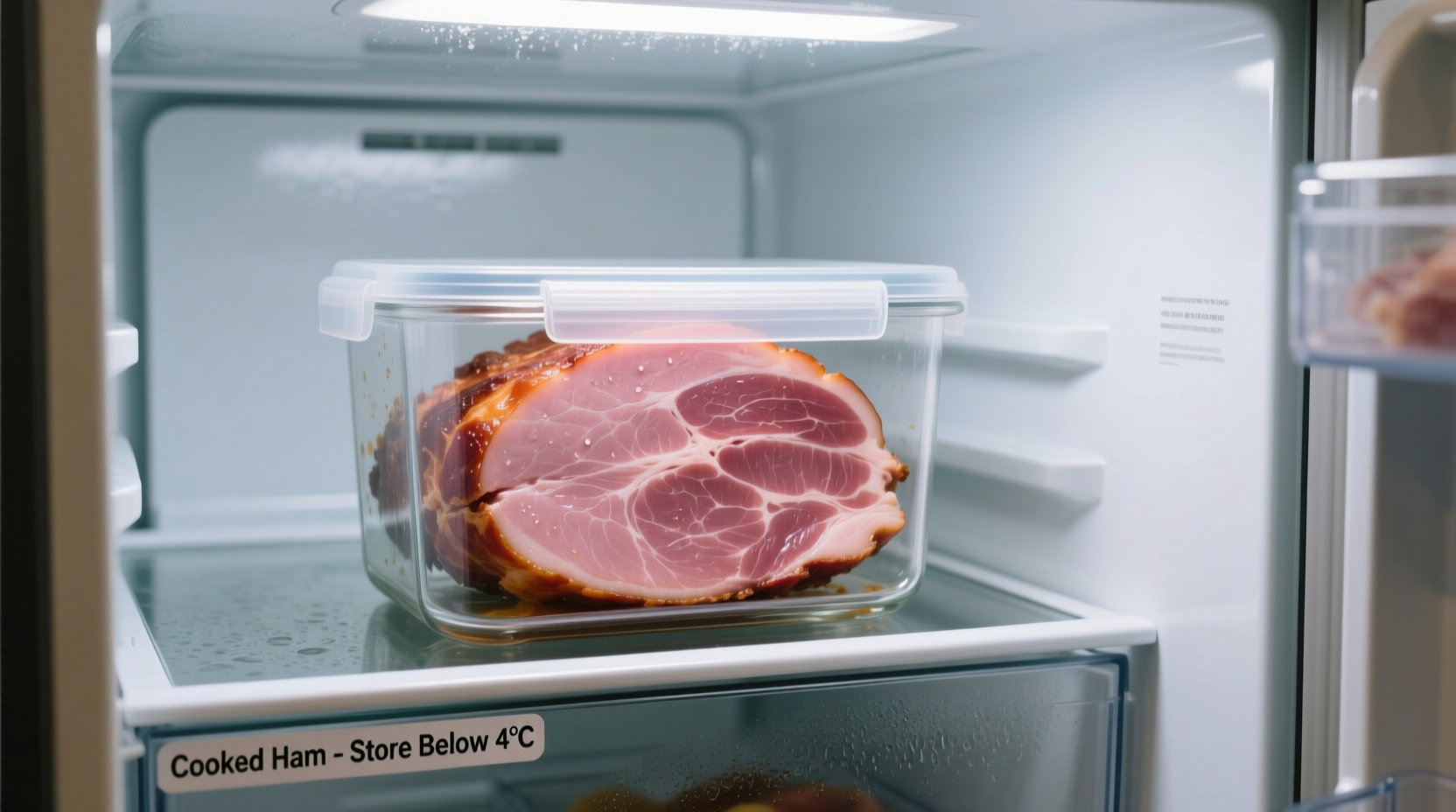Wondering if that leftover ham from your holiday dinner is still safe to eat? You're not alone. Each year, millions of households face this exact question as they try to minimize food waste while staying safe. The clock starts ticking the moment that ham comes out of the oven, and understanding the precise timeline could prevent foodborne illness while helping you make the most of your leftovers.
Understanding Cooked Ham Refrigeration Guidelines
When it comes to cooked ham storage, timing isn't just about freshness—it's a critical food safety issue. The USDA's Food Safety and Inspection Service provides clear guidance that helps consumers navigate this common kitchen dilemma. Let's break down exactly what happens during those crucial days in your refrigerator.
Ham Storage Timeline: What Happens Each Day
Understanding the microbial activity that occurs during refrigeration helps explain why the 3-4 day window exists. Bacteria growth follows a predictable pattern when ham is stored at proper temperatures:
| Day After Cooking | Temperature (40°F/4°C) | Microbial Activity | Recommended Action |
|---|---|---|---|
| Day 1-2 | Optimal | Minimal bacterial growth | Safe for consumption, peak freshness |
| Day 3 | Acceptable | Moderate growth of spoilage bacteria | Consume immediately, check for spoilage signs |
| Day 4 | Risk zone | Significant bacterial multiplication | Discard if not frozen, high risk of spoilage |
| Day 5+ | Dangerous | Potential pathogen growth | Always discard, safety risk too high |
Proper Storage Techniques That Maximize Freshness
How you store your cooked ham significantly impacts its shelf life. Follow these evidence-based methods to ensure maximum safety and quality:
- Immediate cooling: Divide large portions into smaller containers to cool faster—within 2 hours of cooking
- Air-tight containers: Use glass or BPA-free plastic containers with secure lids, or vacuum-seal for best results
- Refrigerator placement: Store on middle shelf where temperature is most consistent (not in the door)
- Temperature verification: Use a refrigerator thermometer to confirm 40°F (4°C) or below

Recognizing When Ham Has Spoiled
While the 3-4 day rule provides a safety guideline, visual and sensory checks offer crucial confirmation. The FDA Food Code emphasizes multiple indicators of spoilage beyond just time:
Visual signs: Look for slimy texture, unusual discoloration (green, gray, or black spots), or visible mold growth. Note that some hams may naturally darken slightly at the edges.
Smell test: Fresh cooked ham has a mild, slightly sweet aroma. Discard immediately if you detect sour, rancid, or ammonia-like odors—these indicate significant bacterial growth.
Texture changes: Properly stored ham should maintain firmness. If it becomes slimy, sticky, or excessively dry, it's time to discard it.
Special Considerations for Different Ham Types
Not all hams follow the same timeline. Understanding these variations helps prevent unnecessary waste while maintaining safety:
- Whole cooked ham (unopened vacuum-sealed): Maintains quality for 1-2 weeks past "use by" date if unopened
- Sliced deli ham: 3-5 days after opening, but only 3 days if sliced at home from whole ham
- Canned ham: 6-9 months unopened, 3-4 days after opening
- Honey-baked or glazed hams: Sugar content may accelerate spoilage—strictly adhere to 3-day maximum
These variations reflect different processing methods and ingredients that affect microbial growth rates. The USDA notes that added sugars and glazes create more favorable conditions for bacteria.
Extending Ham's Shelf Life Through Freezing
When you can't consume ham within the 3-4 day window, freezing provides a safe alternative. The National Center for Home Food Preservation confirms that properly frozen ham maintains safety indefinitely, though quality peaks within specific timeframes:
- Sliced ham: 1-2 months for best quality
- Whole ham: 1-2 months (smaller portions freeze and thaw more evenly)
- Ham with glaze: 1 month maximum before flavor degradation
For optimal results, wrap ham tightly in freezer paper or vacuum-seal, removing as much air as possible. Thaw frozen ham in the refrigerator—not at room temperature—to maintain safety.
Food Safety Context: Why These Guidelines Matter
These storage recommendations aren't arbitrary—they respond to specific food safety concerns. Cooked ham provides ideal conditions for pathogens like Staphylococcus aureus and Listeria monocytogenes, which can grow even in refrigerated conditions. The USDA updated these guidelines in 2022 based on new research showing these bacteria can reach dangerous levels by day 5 in previously considered "safe" storage conditions.
Particularly vulnerable populations—including pregnant women, young children, older adults, and immunocompromised individuals—face significantly higher risks from consuming ham stored beyond recommended timeframes. The CDC reports that deli meats, including ham, account for approximately 12% of listeria-related foodborne illness cases annually.
Practical Leftover Strategies
Maximize your ham while staying safe with these professional kitchen-tested approaches:
- Day 1: Portion leftovers immediately after the meal—don't let ham sit at room temperature
- Day 2: Transform leftovers into sandwiches, salads, or casseroles for variety
- Day 3: Use remaining ham in cooked dishes like soups or quiches (heating to 165°F kills potential bacteria)
- Day 4: Freeze any uneaten portions or discard
Remember that reheating does not make spoiled ham safe to eat—pathogenic bacteria produce heat-stable toxins that cooking cannot eliminate. When in doubt, throw it out.
Common Questions About Cooked Ham Storage
Here are answers to frequently asked questions based on current food safety research and guidelines:
Can I eat cooked ham after 7 days in the refrigerator?
No, cooked ham should not be consumed after 4 days in the refrigerator according to USDA guidelines. After this timeframe, even properly stored ham may contain dangerous levels of bacteria that can cause foodborne illness. The risk increases significantly after day 5.
Does vacuum sealing extend cooked ham's refrigerator life?
Vacuum sealing can extend cooked ham's refrigerator life to 5-7 days, but only if the ham was sealed while still hot and the vacuum process created a proper seal. However, the USDA still recommends consuming within 4 days for maximum safety, as vacuum environments can sometimes encourage growth of anaerobic bacteria.
How can I tell if cooked ham is still good if it's been 4 days?
Even if cooked ham appears normal after 4 days, it may contain harmful bacteria. Check for visible mold, slimy texture, sour odor, or unusual color. However, dangerous pathogens often don't produce visible signs. When stored beyond 4 days, the safest practice is to discard the ham regardless of appearance.
Can I freeze cooked ham after it's been in the refrigerator for 3 days?
Yes, you can safely freeze cooked ham that has been refrigerated for 3 days. Freezing stops bacterial growth completely. Properly wrap the ham in freezer paper or vacuum-seal it, removing as much air as possible. Frozen ham maintains best quality for 1-2 months, though it remains safe indefinitely at 0°F (-18°C).
Does reheating cooked ham kill all bacteria?
Reheating cooked ham to 165°F (74°C) kills active bacteria, but it doesn't eliminate heat-stable toxins produced by certain bacteria during spoilage. If ham has been stored too long and has begun to spoil, reheating won't make it safe to eat. Always follow the 3-4 day refrigeration guideline rather than relying on reheating for safety.











 浙公网安备
33010002000092号
浙公网安备
33010002000092号 浙B2-20120091-4
浙B2-20120091-4